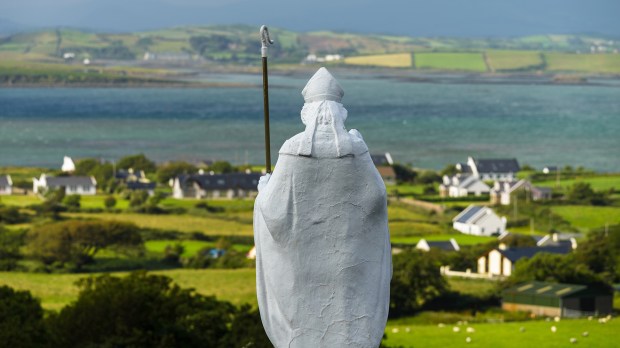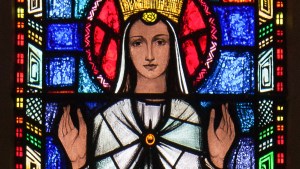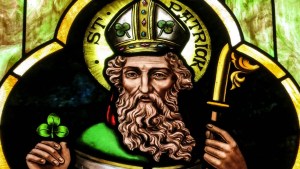Lenten Campaign 2025
This content is free of charge, as are all our articles.
Support us with a donation that is tax-deductible and enable us to continue to reach millions of readers.
How to observe a centennial that is a source of pride for some people and a cause for sorrow for many others who live in the same place? That is the quandary faced by religious leaders in Ireland as both the north and the south remember the events leading up to and in the wake of December 6, 1921.
Yesterday, in Northern Ireland, spiritual leaders sought to grapple with that quandary as they held a church service to mark the centennial of the partition of Ireland and the formation of Northern Ireland.
The “Church Leaders Group,” representing the five main Christian denominations in Ireland — the Church of Ireland, the Roman Catholic, Presbyterian, and Methodist Churches, and the Irish Council of Churches — gathered in the Cathedral of St. Patrick in Armagh Thursday for a “Service of Reflection and Hope.” They were joined by about 300 guests, including British Prime Minister Boris Johnson; Minister for Foreign Affairs Simon Coveney; Northern Ireland’s First Minister Paul Givan; the Northern Secretary Brandon Lewis; leaders of the various political parties; young people, and over 100 community leaders working in peace-building, community development, health, youth work, and various aspects of church life.
Queen Elizabeth II was to have attended as well, but she cancelled a planned two-day visit to Northern Ireland on the advice of her doctors to rest. On Thursday evening, Buckingham Palace confirmed a report that she had spent Wednesday night in hospital after undergoing medical tests.
Though situated in Northern Ireland, Armagh is considered the ecclesiastical capital of all Ireland. It is where, according to tradition, St. Patrick founded his main church in 445, and is the seat of the Archbishops of Armagh, the Primates of All Ireland for both the Roman Catholic Church and the Church of Ireland.
Example of St. Patrick
One of the religious leaders speaking at Thursday’s service reached back way beyond the events of 1921, to St. Patrick himself, to offer a model for Irish still seeking peace and reconciliation.
St. Patrick had been brought to Ireland and enslaved as an act of violence, said the President of the Methodist Church in Ireland, Rev. Sahr Yambasu.
“Patrick had every reason to hate the Irish and seek for vengeance,” said Yambasu, a native of Sierra Leone. “But he didn’t. Instead, he forgave and was forgiven. Consequently, the history of this place could be summarized in one word: grace – unmerited concern for the good of the other.
“For us Christians, grace is a gift. That gift is a person. Jesus Christ is his name. He is the gift of God to St. Patrick,” Yambasu continued. “It is that gift that made him return to Ireland not to hold the past against the people of Ireland, but to hold before them the possibility of a mutually enhanced future: a future devoid of recriminations and unjust relationships; and a future imbued with and infused by grace.”
Yambasu concluded that “reconciliation refuses to see people through any other lens other than how God sees them — as made in his image.”
In a Centenary Prayer , those present at the Armagh service acknowledged “different and often polarized interpretations of history” and prayed that they might “learn from the experiences of the past … so that the inheritance we pass on to the next generation is a gift of understanding, peace and hope.”
Could Churches have done more?
The Catholic Primate of All Ireland, Archbishop Eamon Martin, also spoke at the Armagh service, speculating that Churches could have done more a century ago “to deepen our understanding of each other and to bring healing and peace to our divided and wounded communities.”
“When I look back on what happened on this island in 1921, like many others in my community and tradition, I do so with a deep sense of loss; and also sadness. For the past 100 years partition has polarized people on this island. It has institutionalized difference, and it remains a symbol of cultural, political and religious division between our communities,” Archbishop Martin said.
Martin cited the example of the Good Samaritan, “who crossed social and historic barriers to show love and mercy to the one who was on ‘the other side.’” That is “why I stand here today, as a disciple of Jesus, with my brothers and sisters in faith, hopeful and committed to doing what we can to build a better future for all, a future in which mistrust and division can become things of the past.” he said.
Church of Ireland Archbishop of Armagh John McDowell also expressed regret that Churches “didn’t do more to become peacemakers, or at least to speak peace into the situation.”
“Too often we allowed the attitudes around us to shape our faith, rather than the other way around,” Archbishop McDowell said.
The Rev. David Bruce, the Presbyterian Moderator, said he had “mixed feelings” looking back over the last 100 years. “Northern Ireland is my home too, and I love it,” Bruce said. “But I lament the physical and emotional pain which has been caused over this last century to so many people by violence and the words which lead to violence. Sadly such things remain, and not only on this island. In hope, we long for a day when, as the Apostle John describes it, God will wipe every tear from our eyes, and there will be no more death, or mourning, or crying or pain.”
Ivan Patterson, President of the Irish Council of Churches, said that “while it is important that we continue to show leadership to our young people by coming together as Church leaders, we recognize that our failure, even to talk well together about the ways in which the past continues to affect us all, hampers them in addressing that unfinished work of peace so important for the future. … They are a generation who want to build peace, a generation who respect and care for this planet in solidarity with the poorest and most vulnerable here and around the world.”
A Lesson in History
“In this condition of virtual civil war Britain gradually alienated Irish public opinion and was forced, partly under American influence, to pass the Government of Ireland Act (1920),” the encyclopedia says. “By this measure Ireland was divided into two self-governing areas, Northern Ireland and Southern Ireland. Both were to enjoy, within the United Kingdom, limited powers of self-government. After a general election in Ireland, King George V opened the Parliament of Northern Ireland in Belfast (1921) and in his speech appealed for an end to fratricidal strife. The King’s initiative forced the British prime minister [David] Lloyd George to open negotiations with [Eamon] De Valera [a surviving member of the Easter Rising and later prime minister], but for some time progress proved impossible, because neither side would admit the other’s legality.”
Ultimately, on December 6, 1921 the Anglo-Irish agreement established the Irish Free State, consisting of the lower 26 counties, as an independent member of the British Commonwealth.
The Irish Republicans accepted the treaty only because Lloyd George had threatened war if it was rejected. “Particularly obnoxious were a prescribed oath of allegiance to the British crown and the provisions allowing Northern Ireland to remain outside the new State,” the encyclopedia explains. A civil war then did break out.



